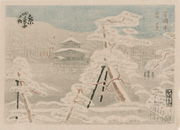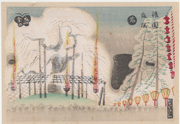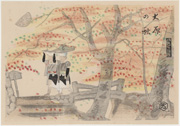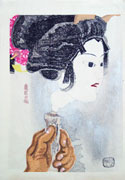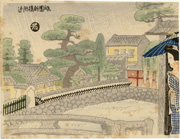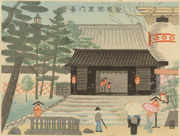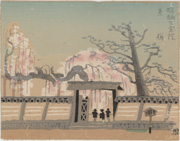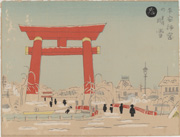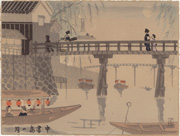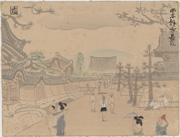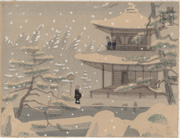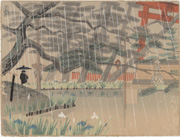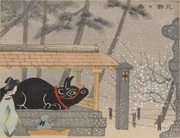Prints in Collection
from the set Four Seasons of Kyoto
IHL Cat. #1743
from the set Four Seasons of Kyoto
IHL Cat. #1744
Rice Planting, 1951
IHL Cat. #1063
Nishihongan-ji Nagatsuji
from the series New Famous Places of Kyoto, after 1953
IHL Cat. #1123 and #2194
Ginkakuji Snow Scene
from the series New Famous Places of Kyoto, after 1953
IHL Cat. #1124
Umenomiya Shrine
from the series New Famous Places of Kyoto, after 1953
IHL Cat. #1125 and #2191
Plum Tree at Kitano Tenmangu Shrine from the series New Famous Places of Kyoto, after 1953
IHL Cat. #2195
Biographical Data
Biography
Kamei Tōbei 亀井藤兵衛 (1901-1977)Sources: Guide to Modern Japanese Woodblock Prints: 1900-1975, Helen Merritt, University of Hawaii Press, 1992, p. 52; Japanese Wood-block Prints, Shizuya Fujikake, Japan Travel Bureau, 1938 revised 1949, p. 114.
Kamei Tōbei was born in Wakayama Prefecture south of Osaka in the Kansai Region with the given name Eiichi. He used the name Kamei Tōbei until 1953 when he changed it to Kamei Genbei (Kamei Gengei) 亀井 玄兵衛. He was a graduate of the Kyoto Kaiga Semmon Gakko (Technical School of Painting) where he studied with Kawabata Ryūshi (1885-1966) and Yamada Kōun (1878-1956). He became interested in prints while an undergraduate and exhibited his prints at Teiten and Kokugakai. He was a founding member of Kyoto Sosaku Hanga Kyokai in 1929 and was a member of the group that published Taishu hanga (Popular Prints), a short-lived 1931 print magazine. He contributed to various Uchida published series, such as Fifty Studies in Flowers and Twenty-Four Views in and out of Kyoto (see image below) which were collaborations with Kotozuka Eiichi (1906-1979) and Tokuriki Tomikichirō (1902-2000). He created a number of small postcard-size prints showing famous scenes of Tokyo, titled Ten Lovely Sights in Tokyo, and of Kyoto titled Ten Lovely Sights in Kyoto. He is one of the founders of the Kōrokusha publishing house with Kotozuka and Tokuriki. From 1937 Kamei exhibited Japanese-style painting (nihonga) with Seiryusha which promoted Japanese-style painting and he became a full member of Seiryusha in 1950.
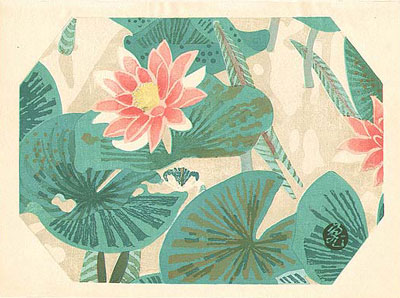
Kamei's design Water Lilies
for the series Fifty Studies of Flowers

for the series Fifty Studies of Flowers
Artist's Seals and Signatures
Most of the artist's seals seem to be a script variation of "kame" or "tō."
 |  |  | 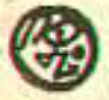 |  |  | 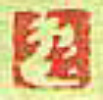 | |
 |  |  |  と? | 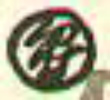 |  |  Kame |  ト? To? |

Kamei Tōbei
亀井 藤兵衛
亀井 藤兵衛
![Picture of the Shop of Owariya Denzaemon at Kyo[to] Kurumayacho Nijo from the set Four Seasons of Kyoto](kamei-tobei-1901-1977/Kyoto Owariya Four Seasons of-f65b213f0f9fa649.jpg)
